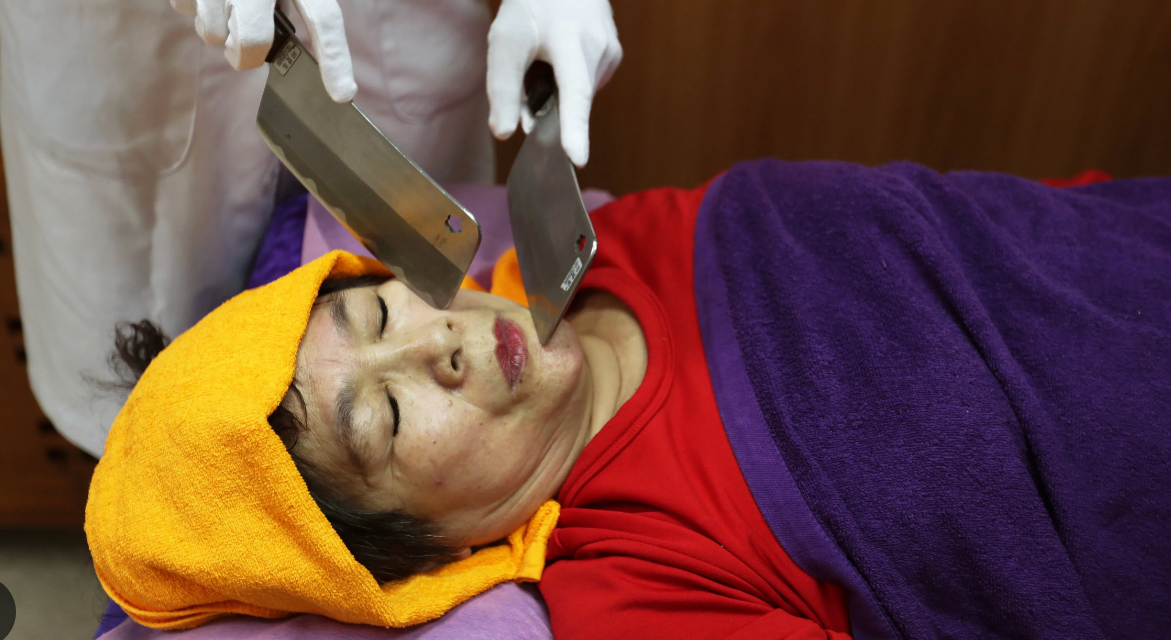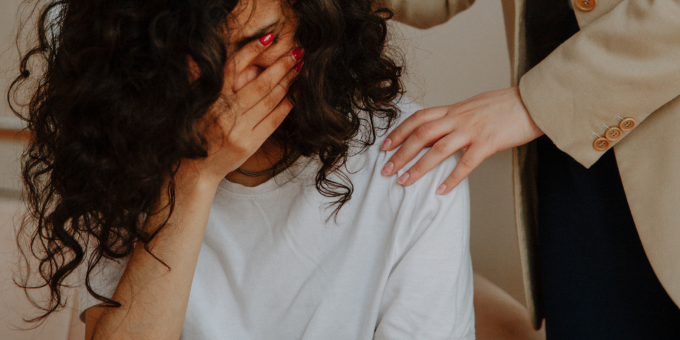In the bustling streets of Taiwan, amidst the vibrant culture and ancient traditions, lies a unique practice that dates back over two millennia: knife massage – don’t worry, there’s no bloodshed involved. But what does it actually involve? Let’s cut to the chase.
This ancient healing art, known locally as "daoliao," involves using a dull-edged blade to gently press and scrape the skin, promoting relaxation, rejuvenation, and overall wellbeing.
Stress Relief and Relaxation
One of the primary benefits of knife massage is its ability to relieve stress and tension from the body. As the blade glides across the skin, it stimulates the release of endorphins, neurotransmitters that promote feelings of relaxation and happiness. The rhythmic scraping motions also help to soothe muscle tension, allowing the body to unwind and let go of built-up stress.
Improved Circulation and Detoxification
Knife massage is believed to enhance blood circulation and lymphatic drainage, helping to remove toxins and waste products from the body. The gentle pressure applied by the blade encourages the flow of blood and lymph fluid, promoting detoxification and improving the delivery of oxygen and nutrients to cells throughout the body. This can result in improved overall health and vitality.
Pain Relief and Muscle Healing
For centuries, knife massage has been used as a natural remedy for relieving pain and promoting healing in the muscles and joints. The scraping action of the blade helps to stimulate the body's natural healing mechanisms, reducing inflammation and promoting the release of tension in tight muscles. Many people find relief from chronic pain conditions such as back pain, arthritis, and fibromyalgia after undergoing regular knife massage sessions.
Skin Rejuvenation
Knife massage is renowned for its ability to promote skin rejuvenation and tightening as a result of the gentle scraping action of the blade which helps to stimulate collagen production in the skin, a protein responsible for maintaining skin elasticity and firmness. The increased blood circulation and lymphatic drainage induced by the massage is believed to help flush out toxins and impurities from the skin, resulting in a clearer, brighter complexion – we’ve yet to see the evidence back this claim up, though. Research suggests that regular knife massage sessions can lead to improvements in skin tone, texture, and overall appearance.
Stress Hormone Regulation

Another fascinating benefit of knife massage is its potential to regulate stress hormones in the body. Studies have shown that massage therapy, including techniques like knife massage, can reduce levels of cortisol, the primary stress hormone, in the body. High levels of cortisol are associated with a wide range of health problems, including chronic stress, anxiety, depression, and even weight gain. By promoting relaxation and reducing stress levels, knife massage may help to regulate cortisol production, leading to improved mood, better sleep, and overall mental wellbeing.
The efficacy of knife massage can be attributed to its impact on various physiological processes within the body. For example, the stimulation of collagen production in the skin is supported by research demonstrating the role of mechanical pressure in activating fibroblasts, the cells responsible for collagen synthesis. Similarly, the reduction in stress hormone levels can be explained by the body's response to touch and pressure, which triggers the release of neurotransmitters like serotonin and dopamine, known for their mood-enhancing effects.
Furthermore, studies have shown that massage therapy can activate the parasympathetic nervous system, responsible for the body's relaxation response, while simultaneously suppressing the sympathetic nervous system, which governs the body's stress response. This dual effect helps to create a state of deep relaxation and calm, allowing the body to repair, rejuvenate, and restore balance. Here's a detailed explanation of how knife massage stimulates this crucial aspect of the autonomic nervous system:
Mechanical Stimulation: When the blade is gently pressed and scraped along the skin during a knife massage session, it creates a tactile sensation that stimulates sensory receptors called mechanoreceptors. These receptors are sensitive to mechanical pressure and movement, and when activated, they send signals to the brain.
Vagus Nerve Activation: The vagus nerve, also known as the "wandering nerve," is a cranial nerve that plays a central role in regulating the parasympathetic nervous system. It innervates many organs in the body, including the heart, lungs, digestive tract, and glands. Research suggests that the mechanical stimulation of the skin during massage therapy can activate the vagus nerve, triggering a cascade of physiological responses.
Release of Neurotransmitters: Activation of the vagus nerve leads to the release of neurotransmitters such as acetylcholine, which has a calming effect on the body. Acetylcholine acts on various organs and tissues, promoting relaxation, slowing heart rate, and enhancing digestion. This neurotransmitter also plays a role in modulating inflammation and pain perception, further contributing to the overall relaxation response.
Autonomic Balance: By activating the parasympathetic nervous system, knife massage helps to restore balance to the autonomic nervous system. The autonomic nervous system consists of two branches: the sympathetic nervous system, which governs the body's "fight or flight" response, and the parasympathetic nervous system, which promotes relaxation and recovery. Chronic stress and anxiety can dysregulate this balance, leading to a range of health problems. Knife massage, by promoting parasympathetic activation, helps to counteract the effects of stress and restore equilibrium to the autonomic nervous system.
What Separates Knife Massage from the Crowd?

Knife massage stands out from other massage techniques due to its unique approach and cultural significance. Here are some key aspects that make it special:
Cultural Heritage: Knife massage has a long history and cultural significance, particularly in Asian countries like Taiwan and China. It is often passed down through generations and is considered a traditional healing art. The practice is deeply rooted in traditional Chinese medicine and reflects ancient principles of holistic health and wellness.
Use of Tools: Unlike traditional massage techniques that rely solely on manual manipulation of the hands, knife massage incorporates the use of special tools, typically made of metal or stone, with smooth, blunt edges. These tools are specifically designed for scraping and gliding over the skin, applying gentle pressure to targeted areas of the body.
Scraping Technique: The scraping motion used in knife massage is distinctive and believed to have therapeutic benefits. Practitioners apply the blade to the skin at a shallow angle, using smooth, rhythmic strokes to stimulate circulation, release tension, and promote the flow of qi, or vital energy, throughout the body. This scraping technique is thought to remove stagnation and blockages in the body's meridian channels, restoring balance and harmony to the body's energy system.
Efficacy for Certain Conditions: Knife massage is often recommended for specific health conditions, such as musculoskeletal pain, tension headaches, and digestive disorders. Advocates claim that the scraping action of the blade helps to break up adhesions and scar tissue, alleviate muscle stiffness, and improve range of motion. Additionally, the practice is believed to enhance detoxification, boost immunity, and promote overall well-being.
Holistic Approach: Like other forms of traditional medicine, knife massage takes a holistic approach to health, addressing the interconnectedness of the body, mind, and spirit. Practitioners often consider factors such as diet, lifestyle, emotions, and environmental influences when assessing a client's health status and developing a treatment plan. By treating the root cause of health imbalances, rather than just the symptoms, knife massage aims to support the body's natural healing processes and restore equilibrium to the entire system.
Should You Try it?

Before trying knife massage or any other alternative therapy, consider the following:
Training and Qualifications: It's essential to seek treatment from a qualified and experienced practitioner who has received proper training in knife massage techniques. Look for practitioners who are certified or licensed in traditional Chinese medicine or massage therapy.
Comfort Level: Some people may feel uncomfortable or apprehensive about the idea of knife massage, particularly if they are unfamiliar with the practice or have a fear of sharp objects. It's important to listen to your intuition and choose therapies that align with your comfort level and personal beliefs.
Benefits vs. Risks: While knife massage is generally considered safe, it's essential to weigh the potential benefits against any potential risks or contraindications. Discuss your health goals and concerns with a qualified practitioner to determine if knife massage is the right choice for you.
If you decide to try knife massage, here are some tips for finding a reputable practitioner:
- Research local spas, wellness centres, or clinics that offer traditional Chinese medicine or massage therapy services.
- Ask for recommendations from friends, family members, or healthcare providers who have experience with alternative therapies.
- Verify the qualifications and credentials of the practitioner, including their training, certification, and years of experience.
- Schedule a consultation or introductory session to discuss your health goals, concerns, and any questions you may have about the treatment process.
Feeling inspired? We’ve put in the hard yards so you can enjoy the benefits of an extensive, wholistic program that covers everything from learning how to manage nutrition and mental health to social situations. When you join us for the 8-Week Program you’ll have exclusive access to expert guidance, nutritional planning and support every step of the way. Take a peek at what’s on offer:
- 8 weeks of meal plans and shopping lists.
- A range of exclusive recipes, including sugar-free desserts, snacks and all the old favourites.
- Community forums to share and discuss your experience.
- Expert support to guide you through each week – from world-renowned chef Sarah Glover to yoga teachers, nutritionists and naturopaths.
Don’t wait, JOIN NOW!






Leave a comment (all fields required)